Professional wrestling attacks
Attacking maneuvers are offensive moves in professional wrestling, used to set up an opponent for a submission hold or for a throw. There are a wide variety of attacking moves in pro wrestling, and many are known by several different names. Professional wrestlers frequently give their finishers new names. Occasionally, these names become popular and are used regardless of the wrestler performing the technique.
Professional wrestling contains a variety of punches and kicks found in martial arts and other fighting sports; the moves listed below are more specific to wrestling itself. Many of the moves below can also be performed from a raised platform (the top rope, the ring apron, etc.); these are called aerial variations. Moves are listed under general categories whenever possible.
Bell clap
The wrestler slaps both ears of an opponent simultaneously with the palms of his hands, distorting their balance.[1] It is often used to escape a bear hug.[1]
Body press
Also known as a splash, a body press involves a wrestler falling against the opponent with the core of their body. It is executed from a running or jumping position, using momentum and weight to impact the opponent, and most variations can seamlessly transition into a pin. This attack is a plancha in lucha libre.
Big splash
The big splash involves a wrestler jumping forward and landing stomach-first across an opponent lying on the ground below. On some occasions a wrestler has a short running start before executing the move.
Body avalanche
The wrestler charges into an opponent in the corner of the ring without leaving their feet, crushing them into the turnbuckle. This is normally used by bigger, heavier wrestlers.
Crossbody
Also known as crossbody block, this is a maneuver in which a wrestler jumps onto his opponent and lands horizontally across the opponent's torso, forcing them to the mat and usually resulting in a pinfall attempt. There is also an aerial variation, known as a diving crossbody, where wrestler leaps from an elevated position towards the opponent.
Lou Thesz press
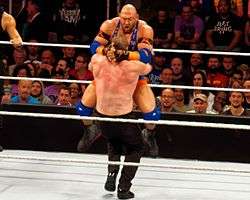
This move, innovated by, popularized and subsequently named after Lou Thesz, sees the attacking wrestler jump towards a standing opponent and knock him over, resulting in the opponent lying on his back with the attacking wrestler sitting on the opponent's chest, pinning him in a body scissors.[1] A variation of the Lou Thesz press, popularized by Stone Cold Steve Austin, involves the attacking wrestler jumping on a running opponent, then repeatedly striking the opponent in the face while in the mounted position.
Stinger splash
A move named after Sting, who popularized it. The Stinger splash involves the wrestler trapping his opponent in a corner. The wrestler will then charge at the opponent, usually from the opposite corner, and launch himself at the opponent just before reaching him resulting in him hitting the opponent with his chest and abdominal area, sandwiching the opponent between him and the turnbuckle.
Tilt-a-whirl crossbody
An uncommon variation of the move which sees the wrestler being held and spun into a tilt-a-whirl by the opponent, and when the wrestler reaches a point where he is horizontally positioned against the opponent's torso, he falls down, pushing down the opponent onto his back against the canvas. This move is better described as a crossbody as a counter of a tilt-a-whirl backbreaker/tilt-a-whirl mat slam.
Vertical press
A vertical splash is a jumping attack made against a standing opponent, landing against the opponent's upper body while remaining upright, and bringing them down to the mat into a vertical splash (seated senton) position.
Bronco buster

In the bronco buster, an opponent is seated in the corner of the ring while the attacking wrestler jumps in the corner, straddling his or her opponent's body, and bounces up and down on the opponent's chest.[2] The bronco buster is normally treated as having comic or sexual connotations rather than as a legitimately painful move, the latter particularly true during some matches between female wrestlers.
Koronco buster
Similar to a bronco buster, the attacking wrestler jumps onto a standing opponent in the corner, straddling and sitting on the opponent's chest, and rests his feet on the second rope. The attacking wrestler then follows with mounted punches.
Chops
Backhand chop

The act of a wrestler to slap the chest of his opponent with the palm of the hand using a backhand swing.[1] Many wrestlers use this chop, often referring to it as a knife edge chop. Because it was popularized by Ric Flair the crowd always responds with a "woo" noise.
Cross chop
A variation of the aforementioned chop, the wrestler runs and lunges forward in a crossbody-esque fashion while crossing their arms in an "X" fashion and then hits a double backhand chop to the opponent.
Forehand chop
Sometimes referred to as a frying pan chop or an open-hand chop. The act of slapping the chest of the opponent using the forehand.[1]
Kesagiri chop
A downward diagonal backhand chop to the side of the opponents neck.
Mongolian chop
The act of 'karate chopping' both the opponent's shoulders and sides of the neck with the hands' edges in a swinging motion at the same time.
Overhead chop
Also known as a brain chop or a tomahawk chop. The wrestler draws his hand back and hits the opponent vertically with a backhand chop, usually hitting the head. This move is primarily used by large, very tall wrestlers such as The Great Khali and Andre the Giant.
Clothesline
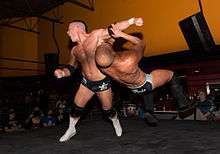


A clothesline is a move in which one wrestler runs towards another and extends his/her arm out from the side of the body and parallel to the ground, hitting the opponent in the neck or chest and knocking him/her over.[3] This move is often confused with a lariat.[4]
Cactus clothesline
A clothesline used by Mick Foley that is named after his "Cactus Jack" gimmick.[5] The attacking wrestler charges at an opponent who is against the ring ropes and clotheslines him/her, and the force and momentum from the charge knocks both the wrestler and the opponent over the top rope and onto the floor.[5]
Corner clothesline
A clothesline used by a wrestler where instead of knocking a standing opponent, the wrestler charges against an opponent on the corner.
Leaping clothesline
Also known as a jumping clothesline or flying clothesline, this move involves the attacking wrestler running towards an opponent, then leaping into the air before connecting with a clothesline. This variant's use is commonly associated with The Undertaker and Roman Reigns. Another version sees an attacking wrestler leap up into the air and connecting with a clothesline onto an opponent leaning against the corner turnbuckle.
Rebound clothesline
As the opponent runs to the ropes on one side of the ring and rebounds against them, the attacker also runs to the same ropes and rebounds against them after his opponent has done so, ensuring that he is behind his opponent. As his opponent then turns around to face the attacker which is behind him, the attacker executes a regular clothesline to his opponent.
Short-arm clothesline
Also known as a short clothesline or short-range clothesline, this variation is set up by Irish-whipping the opponent, but holding onto the arm. When the held arm is completely extended, the wrestler pulls the opponent back and clotheslines him with the other arm.[1] Alternatively, this move can be performed in the same fashion, but following an arm wrench or wrist lock instead of an Irish whip, or by simply grabbing hold of one of the opponent's arms with one the wrestler's hands, pulling it towards the wrestler and clotheslining him with his spare arm.
Springboard clothesline
With a multitude of variations, this move implies that the wrestler jumps on to a rope and springboards off it into the opponent. The most basic version is the wrestler is on the apron, then goes to the top rope, and hits it on the opponent in the ring or onto the floor. Another version has the wrestler jump to the second rope, springboard off over the top rope, and clothesline the opponent on the apron.
Three-point stance clothesline
In this move, a wrestler uses a three-point stance and then clotheslines his opponent.
Double axe handle
Also known as a Double Sledge, Polish Hammer or Double Axe Hammer, this attack sees the wrestler clutches both hands together and swing them at an opponent, hitting any part of them—usually their back, neck, or chest. The Polish Hammer name comes from its most noted user, Ivan Putski. The other names come from the attack mimicking the motion seen when people swing a sledgehammer or axe. There is also a top rope variation.
Drops
Drops are moves in which wrestlers jump or fall down onto a person on the floor, landing with a specific part of the body
Butt drop
Chop drop
The wrestler either falls forward, or jumps up and drops down, hitting a lying opponent with a backhand chop on the way down. The wrestler usually lands on his knees.
Elbow drop




An elbow drop is a move in which a wrestler jumps or falls down on an opponent driving his or her elbow into anywhere on the opponent's body.[1] A common elbow drop sees a wrestler raise one elbow before falling to one side and striking it across an opponent. Another common elbow drop is the pointed elbow drop that sees a wrestler raise both elbows up and drop directly forward dropping one, or both elbows onto the opponent.
Corkscrew elbow drop
This variation sees the wrestler raise one elbow before falling and simultaneously twisting around as they fall to one side, striking the opponent with the elbow anywhere on their body. Sometimes, the wrestler will swing one leg around before they fall, gaining momentum for the corkscrew twist,first invented by Nature Boy Buddy Landel in 1984.
Spinning headlock elbow drop
This is any elbow drop which is performed after applying a headlock, the most widely known variation is an inverted facelock elbow drop in which a wrestler puts his opponent into an inverted facelock, and then turns 180°, dropping the elbow across the opponent's chest, driving him down to the mat. Another variation of this move sees the executor use their whole arm as a lariat instead of just the elbow. A side headlock can also be executed from a jumping position, and twisted around into a sitout lariat.
Fist drop
A fist drop is a move in which a wrestler jumps/falls down on an opponent driving his fist into anywhere on the opponent's body.[1]
Forearm drop
A forearm drop is a move in which a wrestler jumps down on an opponent driving his forearm into anywhere on the opponent's body.
Headbutt drop
A headbutt drop is a move in which a wrestler jumps/falls down on an opponent driving his head into anywhere on the opponent's body.[1]
Knee drop
A knee drop is a move in which a wrestler jumps/falls down on an opponent driving his knee into anywhere on the opponent's body.[1] It is often sold as more powerful if the wrestler bounces off the ropes first.
Knee drop bulldog
A version of a knee drop that involves the wrestler placing one knee against the base of the opponent's neck, who is leaning forward, then dropping. This forces the opponent's head down to the mat, while landing on the opponent's upper body, and driving his knee to the neck of the opponent. There is also a diving version.
Leg drop
A move in which a wrestler will jump/fall and land the back of his leg across an opponent's chest, throat, or face.[1]
Elbow
An elbow attack sees the wrestler using his elbow or back elbow to connect it to the opponent's chest, face, neck etc.

Back elbow
Also known as a reverse elbow, the wrestler stands with his back to a standing or a running opponent, and strikes the opponent with the back of the elbow.
Bionic elbow

This move is a strike that is brought from a high position and travels vertically toward the floor, dropping the point of the elbow directly on the target. This type of "12-6 elbow" is illegal in many mixed martial arts organizations, including the UFC and Strikeforce.[6]
Corner back elbow
The wrestler strikes a back elbow to a cornered opponent, lying (facing inwards or outwards the ring) against the corner. This is usually struck from a running wrestler.
Discus back elbow
The wrestler faces away from the opponent, spins around to face away from the opponent and strikes the opponent's face with a back elbow.
Discus elbow smash
Or more commonly named the roaring elbow, sees the wrestler facing away from the opponent, spins 180° from the direction he stood, and then strikes the opponent with an elbow smash. Another variation sees the wrestler first facing the opponent, spins a full 360° to face the opponent again to hit the opponent an elbow smash.
Elbow smash

The wrestler makes a punching motion, but tucks his or her hand towards the chest so the elbow and forearm make contact.[1] These can be used in place of punches because striking with a clenched fist is illegal in most wrestling matches.
Mounted elbow drop
The wrestler approaches a cornered opponent, climbs the second or top rope beside the opponent with one of his legs on either side of the opponent. The wrestler then jumps off the ropes, and then delivers a bionic elbow to the opponent's head, neck (if the opponent's neck is bent-down) or the shoulder.
Short-arm elbow smash
This variation of an elbow smash is set up by Irish-whipping the opponent, but holding onto the arm. When the held arm is completely extended, the wrestler pulls the opponent back and hits him with an elbow smash using the other arm. Alternatively, this move can be performed in the same fashion, but following an arm wrench or wrist lock instead of an Irish whip, or by simply grabbing hold of one of the opponent's arms with one the wrestler's hands, pulling it towards the wrestler and elbowing him with his spare arm.
Facewash
With an opponent sitting against the bottom corner turnbuckle, an attacking wrestler repeatedly rubs the sole of their boot across the face of the opponent, and then executes either a running front kick, a running knee, a running low-angle big boot, a running low-angle single leg dropkick or other strikes that first see the attacking wrestler rebound off the opposing ropes and charge at the opponent.
Forearm club

An attacking wrestler uses one hand to take hold of an opponent (by their head or hair) and lean them forward while extending his or her other arm in a raised position and clenching the fist of that hand before throwing the arm forward down onto the opponent; using his or her forearm and clenched fist to club the opponent across the back of his or her head/neck. This will often send the opponent to the mat front-first. A lesser used version of this move can see the attacking wrestler take hold of an opponent and lean him or her backwards to expose his or her chest area, allowing the attacking wrestler to club the chest of the opponent and send him or her to the mat back-first.
Forearm smash
An attacking wrestler charges at the opponent and then hits the opponent in the chest or face with a forearm to force them back and down to the mat.[1]
Flying forearm smash
While running towards an opponent (usually after bouncing off the ropes), an attacking wrestler would leap up into the air, before connecting with a forearm smash.
Sliding forearm smash
While running towards an opponent (usually after bouncing off the ropes), the attacking wrestler does a slide across the mat, before connecting with a forearm smash.
Headbutt
An attack where a wrestler uses his head to strike a part of the opponent's body, usually the head or skull, to daze him.[1] Unlike a legitimate headbutt, the pro-wrestling version most often impacts with the opponent's forehead, counting on the superior hardness of the wrestler's head and the momentum delivered to hurt the opponent without hurting the wrestler. Many wrestlers deliver a headbutt to an opponent's head by holding the opponent's head and delivering the headbutt to their hand instead, relying on the intervening hand to cushion the blow.
Battering ram
The wrestler stands facing an upright opponent, lowers their head and then jumps or charges forwards, driving the top of their head into the abdomen of the opponent. There is also a double-team version of the move.
Trapping headbutts
The wrestler holds both the opponent's arms under his own, and delivers a series of headbutts to his opponent, who is unable to counter.
Knee strikes
Attacks where a wrestler will strike an opponent using their knees. The idea of using knees as an offensive weapon is popular throughout British wrestling.
Go to Sleep
Also known as the Go to Sleep and sometimes abbreviated to GTS, this move sees a wrestler place an opponent in a fireman's carry and proceed to drop the opponent in front of them. While the opponent is falling, the wrestler quickly lifts a knee up, striking the opponent in the face. Kenta, the creator of the move, also uses an inverted variation in which he lifts his opponent into an Argentine backbreaker rack, throws his opponent forward, and strikes the back of the opponent's head with his knee. Former WWE wrestler CM Punk is also known for using the move.
Double knee
An attack where a charging wrestler strikes both of their knees simultaneously into the head, chest or back of the opponent.
High knee

An attack in which a wrestler will charge towards their opponent, then jump up and raise their knee so that it hits the opponent usually into the side of the head or face.[1] This move has been closely associated with Harley Race, often being referred to as a "Harley Race-style High Knee". It has later been popularized as a signature move by WWE Superstars Triple H and CM Punk.
Running single leg high knee
Similar to a running single leg dropkick. The attacking wrestler runs and leaps toward an opponent while bending one of his knees, striking the opponent in the face with the bent knee. This move was made popular in Japan by Kenta Kobayashi. The move was later adopted by WWE wrestler Daniel Bryan.
Shining Wizard
A strike delivered to an opponent down on one knee. After stepping off the opponent's raised knee with one foot, the wrestler swings his other leg and strikes the opponent's head with either the side of his knee or his shin. A slight variation, which sees the wrestler use a running enzuigiri to the kneeling opponent's head without the use of the opponent's knee for leverage, is known as a Shining Apprentice. Many other "shining" attacks exist, including big boots and dropkicks. The shining wizard can be applied to a standing opponent as well; this would be likely applied by stepping off the opponent's chest and then delivering a knee smash to the opponent's face. The move was created by Keiji Mutoh, otherwise known as the Great Muta.
Spinning knee
Also known as a discus knee or rolling knee, the wrestler advances towards the opponent, performs a 360° spin and uses the momentum to deliver a jumping knee strike to the opponent's head. This maneuver can be delivered to a sitting or standing opponent.
Hip attack

Also known as a butt bump/butt thump, this attack is usually performed with a running start, when wrestler jumps into the air, spins around, and thrusts his pelvis backwards, thus hitting the opponent's head or chest with his hip or buttocks.[1]
Kick
A kick is an attack using the foot, knee or leg to strike any part of the opponent's body.
Back kick
The back kick, also known as the reverse side kick, involves the attacker originally facing his opponent. The attacker then turns 180 degrees so that his back is now facing the opponent and extends a leg backwards, exploiting the turning momentum to strike the opponent in the chest or stomach with the sole of his foot. A jumping back kick involves the attacker conducting the turning motion as he jumps.[1]
Backflip kick
While the attacker has his or her back to the opponent, he or she performs a standing back flip and hits the opponent in the head with one or both his or her legs, with the wrestler usually landing on his or her hands and/or feet facing downward.[1] Also known as a Pelé kick after the association football player.
Corner backflip kick
This move sees an opponent propped up in the corner as an attacking wrestler charges towards him or her, running up the ropes (that are beside the opponent), or in some cases, up the opponent, and, as he or she reaches the top, kicking off this opponent's chest to perform a backflip so the wrestler lands on his/her feet.[1]
Big boot

Otherwise known as the Yakuza kick or the Mafia kick. This attack is usually done with the opponent charging towards the wrestler, using the opponent's momentum to deliver the wrestler's boot to the upper-body or head.[1] This move is commonly performed by tall wrestlers to enhance its view as a strong attack even though the wrestler themselves are not moving and the opponent is running into their foot, and because of that their height makes it easy for their leg to reach the head of normal-sized wrestlers. There is also an arched variation of this move.
Bicycle kick
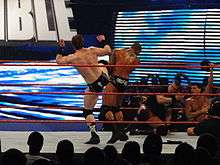
An attacking wrestler jumps up and kicks forward with both feet in a pedalling motion with the foot that gets lifted second being extended fully to catch a charging opponent directly in the face. Another variation sees the attacking wrestler charge at a standing opponent before delivering the attack. It is similar in effect to the big boot. This move is used by Sheamus as a finisher, who calls it the Brogue Kick.
Bicycle toe kick
This move is a combination between the "Bicycle" and "Toe" kick where a wrestler jumps up and kicks forward with one feet stamping the front or shoulder of an standing bent over opponent however this move can be done without the jumping combination. This kick variation was popularized by former WWE Diva Eve Torres.
Calf kick
This kick starts with the wrestler jumping to his either sides, connecting the side of his rear leg to the opponent's face or neck.
Crane kick
The wrestler first performs a crane stance, by standing on one leg, with the other knee raised and arms extended in a crane position. The wrestler then strikes the opponent's head or face with either the standing or raised leg.
Dragon whip
This is a leg lariat or spinning heel kick move which is performed after an opponent catches the leg of a wrestler who has attempted a kick of some sort (i.e. superkick or side kick), then while the opponent throws the leg out away from himself the wrestler continues to spin all the way out with his leg still extended to hit the leg lariat.
Dropkick
A dropkick is defined as an attack where the wrestler jumps up and kicks the opponent with the soles of both feet, this sees the wrestler twist as they jump so that when the feet connect with the opponent one foot is raised higher that the other (depending on which way they twist) and the wrestler fall back to the mat on their side, or front.[1] This is commonly employed by light and nimble wrestlers who can take advantage of their agility.
Enzuigiri

The term Enzui is the Japanese word for medulla oblongata and giri means "to chop". Thus, an enzuigiri (often misspelled 'ensuigiri' or 'enzuiguri') is any attack that strikes the back of the head. It is usually associated with lighter weight class wrestlers, as well as wrestlers who have a martial arts background or gimmick. It is often used as a counter-move after a kick is blocked and the leg caught (called a "leg-feed"), or the initial kick is a feint to set up the real enzuigiri attack. A common variation of the enzuigiri sees the wrestler stepping up the opponent's chest, and hitting the back of the opponent's head with the other leg, or foot.
Football kick
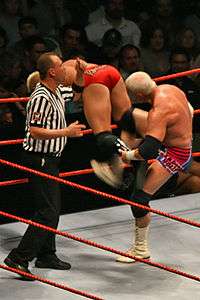
Sometimes also referred to as a soccer kick. The wrestler kicks an opponent, who is sitting on the mat, vertically to their back, with the foot striking the base of the spine, and the shin striking the back of the head.
Jumping high kick
The wrestler jumps up and kicks the opponent in the face or the side of their head. It is properly called a gamengiri, but because of the similar nature can be confused for an enzuigiri.
Legsweep
The wrestler drops to one knee and extends their other leg, then quickly pivots their body around, using their extended leg to knock away the opponent’s legs.[1]
Mule kick
While facing away from a charging opponent, the wrestler bends down and pushes out one foot, striking the opponent with the bottom of it.[1] A double mule kick variation is also possible, usually done with the wrestler facing away from the opponent, sometimes done in a corner. The wrestler jumps and kicks backwards with both legs to the opponent, hitting them with both soles of their feet. If acrobatically inclined, the wrestler can then roll forward into a standing position.
Overhead kick
Similar to a backflip kick, this attack sees the wrestler either start by lying down or drops down on the mat while the opponent standing near their head.[1] The wrestler lifts a leg and kicks up over their waist and chest, hitting the opponent with the top of their foot, usually in the head.[1] Can be used as a counter to an attack from behind.[1] For example, a wrestler attempts a full nelson, the wrestler breaks the opponent’s lock, falls to the canvas and kicks them in the face with their foot.[1]
Punt
Based on the field goal kick but named for the punt kick used in American football, this sees the wrestler take a run up to a kneeling opponent and strike him in the head with the sole of his foot. It is similar to the soccer kick in MMA.
Rolling wheel kick
Also known as an Abisegiri, a Rolling Koppou Kick, or a Rolling Liger Kick. The wrestler rolls towards a standing opponent, extending a leg which connects with the back, chest, or head of the opponent.[1]
Savate kick
The most commonly used kick which is referred to as a "savate kick" in wrestling is the chassé, a piston-action kick, with the sole of the foot to an opponent's head or chin. This kick is in some ways similar to, but not considered, a superkick.
Scissors kick
A version of a leg drop, which is performed on an opponent who is standing, bent over, usually in the middle of the ring.[1] This sees a wrestler bounces off the ropes, jumps, driving his leg(s) into the back of the head and the neck of the opponent, similar to a pair of scissors.[1] Also known as a jumping axe kick or a butterfly kick. A corkscrew variation exists where the attacker twists during the strike, facing the floor while performing the scissor kick.
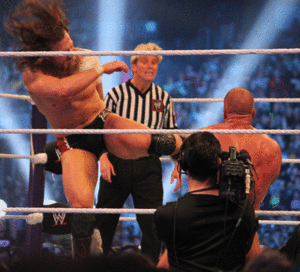
Shoot kick
A kickboxing-style kick with the shin (generally protected by a shin guard) striking an opponent's face, chest or thighs. This move is used in shoot-style environments and by many Japanese wrestlers.
Sole kick
A thrust kick where the wrestler turns his torso away from the opponent while at the same time lifting his leg horizontally and extending it forward, striking the opponent in the torso with the sole of his foot. A spin kick variation sees the wrestler spin around and then perform the sole butt kick with his outer leg, which is known as a rolling sole butt in Japan. There is also jumping variation where the wrestler jumps straight up, spins in the air, and then delivers the sole butt with his outer leg targeting the head of the opponent.

Spin kick
A high kick which gains power and momentum from spinning in place.[1] It is also known as the reverse roundhouse kick. It is similar to the spinning heel kick, but the wrestler does not jump off the ground, making the move a leg lariat of sorts.[1] It is common to see this move executed after an opponent is Irish whipped off the ropes. In Mexico, it is known as La Filomena.
Spinning heel kick
This move usually involves the wrestler spinning 360 degrees as they jump so that his or her body is somewhat horizontal, before hitting their opponent with back of his/her leg(s) or heel(s) on the face, neck or chest.[1]
Stomp
Also known as a foot stomp, this attack sees a wrestler stamp his foot on any part of a fallen opponent.[1] One variation of the stomp sees a wrestler perform a series of stomps all over the body of a fallen opponent in the order of left arm, left chest, left stomach, left upper leg, left lower leg, right lower leg, right upper leg, right stomach, right chest, right arm, and finally the jaw. This has become known as the "Garvin Stomp", as it was innovated by former NWA World Heavyweight Champion Ron Garvin in the late 1980s.
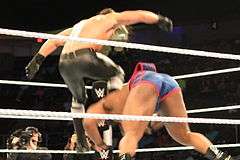
Curb Stomp
Seth Rollins' version of the move was a running stomp to the back of the head of a bent-over opponent, forcing the opponent face-first into the ground.
Double foot stomp
When a wrestler jumps and stamps both feet on any part of an opponent.[1] Also known as a double stomp.[1] This can be performed from an elevated position as a diving double foot stomp.

Superkick
A superkick sees the wrestler delivering a kick to the opponent's face, chin, neck or breastbone, usually preceded by a sidestep, often referred to as a side kick or a crescent kick.[1] "Gentleman" Chris Adams is credited for its innovation.[7] It is famously the finisher of Shawn Michaels, who calls it Sweet Chin Music and occasionally adds theatrics before using the move.

Tiger feint kick
The tiger feint kick is a move in which a wrestler jumps through the second and top rope while holding on to the ropes and uses the momentum to swing back around into the ring. It was originally performed as a fake dive to make opponents and fans think that the wrestler was about to dive through the ropes to opponents outside the ring, and was later modified to become a kick to the head of an opponent who is hung on the second rope. This move requires high agility and is mainly used by smaller wrestlers in Japan and Mexico. It was popularized internationally by Rey Mysterio, who called the move 619 (after area code 619, the area code for Mysterio's hometown of San Diego, California).
Toe kick
The wrestler strikes the opponent in the midsection or stomach with the point of his foot in order to bend the opponent over. This simple kick, used by almost all wrestlers, is used just for show or as a setup for a hold or throw.
Lariat
In wrestling, a lariat is when an attacking wrestler runs towards an opponent, wraps his arm around their upper chest and neck and then forces them to the ground. This move is similar to a clothesline,[4] the difference being that in a clothesline the wrestler's arm is kept straight to the side of the wrestler during the move, while in the lariat the wrestler strikes their opponent with his arm.
A lariat to the back of the opponent's neck and shoulders is sometimes referred to as a northern lariat or enzui lariat. A lariat where the wrestler doesn't run but simply strikes the opponent while standing next to him is sometimes referred to as a short range lariat or a burning lariat. The wrestler can also hold the opponent's head up before performing the lariat with his other arm. A short-arm lariat is a variation where the wrestler grabs one of the opponent's wrists with his hand and pulls the opponent closer, striking him with the lariat with his other arm.
Typically, a lariat is used as a finishing move while the clothesline is simply a basic strike attack. The main difference aside from the mechanics of the movement is the stiffness. Lariats are essentially a very stiff clothesline used as a finisher rather than a basic strike.
Crooked arm lariat
The crooked arm lariat is performed when an attacking wrestler runs towards an opponent with the arm bent upward at the elbow 60–90 degrees and wraps his arm around their head forcing them to the ground.
Flying lariat
The attacking wrestler first uses the ropes to build up speed. When speed is built the attacking wrestler uses the speed to leap forward and wrap his/or her arm around the opponent's neck, causing the power of the force to knock down the opponent.
Lariat takedown
The wrestler runs towards his opponent, wraps his arm around their upper chest and neck of the opponent, and swings his legs forward, using his momentum to pull the opponent down with him to the mat, on to their upper back. This move is also called a running neckbreaker or bulldog lariat.
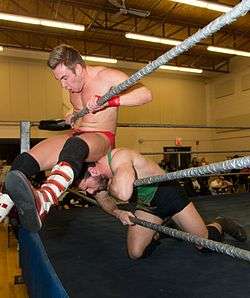
Leg lariat
Also referred to as a jumping leg lariat or a running calf kick this attack is seen when an attacking wrestler runs towards an opponent, jumps and wraps his leg around the opponent's head / neck knocking the opponent to the ground.
Leapfrog body guillotine
This move sees an opponent rest his chest and body on the second rope, facing out of the ring. The attacker, running from behind, jumps and lands on his opponent's back, neck and head, sliding through the ropes out of the ring, forcing the opponent against the second rope.
Punch
A simple close-fisted punch, normally to the body or face of the opponent.[1] Unlike most illegal attacks, punches almost never result in disqualification. Instead, the referee simply admonishes the wrestler to stop, usually to no effect. Punches are often used by both villains and heroes. However, when villains perform the strike while either the opponent is not expecting it, or when the referee is in some way distracted, it seems more devastating and often referred to as a "cheap shot".
Back fist
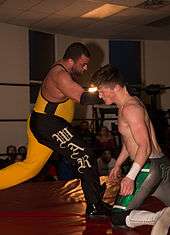
In this variation of a simple close-fisted punch, the wrestler strikes the opponent with the back of their fist.
Spinning back fist
Often aimed at a standing opponent or one sat on the top turnbuckle. The wrestler holds their arm out horizontally and executes a back fist whilst turning their body with speed so that the back of their fist strikes the opponent in the head or chest on rotation.
Heart Punch
The wrestler raises the opponent's left arm up over their head, sometimes folding it back behind their neck as well, then delivers a strong punch into the side of the ribcage. The move is alleged to rely on "Oriental pressure points" to strike a nerve causing the opponent's heart to momentarily stop, rendering them unconscious.
Stan "The Man" Stasiak and Ox Baker are professional wrestlers well known for their use of the Heart Punch as a wrestling maneuver.[8]
Mounted punches
A common variation of the punch involves standing on the middle or top ropes and delivering repeated punches to the face while the opponent is backed up against the turnbuckles. The crowd tends to count the punches, which typically end at ten, provided they're not interrupted by the opponent pushing the wrestler off the ropes.
Another variation usually follows a standing double leg takedown or a Thesz press, with the downed opponent lying on the mat, the wrestler can mount themselves onto the opponent's chest or back and throw punches towards the head area in a similar manner.
Superman punch
This attack sees a wrestler leap into the air before striking the opponent with the fist. Popularized by Roman Reigns.
Wind-up punch
A theatrical variation in which the wrestler rotates their arm in a "winding-up" motion before striking the opponent, making the punch appear more effective. Commonly used by Hulk Hogan.
Slap
The wrestler delivers an overpowering open-hand slap to their opponent.
Double slap
The wrestler slaps both of the opponent's cheeks with both of their hands. This can sometimes be referred to a bell clap.
Palm strike
Known as a Shotei, this move sees the wrestler deliver an open-hand strike with the palm of their hand, usually to the chin of the opponent.
Senton
Similar to a big splash, except the wrestler jumps over an opponent while falling backwards to land back-first on the opponent.[1] Often referred to as a senton splash or back splash in reference to the big splash as well as to differentiate from the senton's diving version. Another slight variation on a standard senton sees the attacking wrestler jump forward and perform a somersault (front flip) to land back-first on the opponent. This is appropriately known as a somersault senton, but is also referred to as a front flip senton/rolling senton.
Cannonball

This is a front flip senton performed to an opponent sitting in a corner. With the opponent seated the wrestler runs at the opponent and flips forward 180° so that their back impacts on the opponents chest and head causing the opponent to be sandwiched between the turnbuckle and the wrestler.
Seated senton
A seated senton, also known as a vertical splash or butt drop, is a maneuver in which a wrestler jumps down to a sitting position across the chest or stomach of a fallen opponent. This particular move is usually executed one of two ways. One is to see the wrestler stand over the opponent and drop to either a seated position (like Rikishi) or a kneeling position (like Bastion Booger's Trip to the Batcave). The other is performed with the opponent laying near one of the turnbuckles, with the wrestler climbing to the middle rope and bouncing on it before performing the senton (Yokozuna's Banzai Drop). A variation of the seated senton was performed by Earthquake, whose Earthquake Splash would see him run off the ropes to gain momentum for the senton and then jump onto the opponent while running. It is also an obvious and often-used counter to the sunset flip.
Shoulder block
A shoulder block sees a wrestler strike an opponent with their shoulder usually ramming their shoulder, by keeping their arm down by their side, into the opponent's shoulder or abdomen of an opponent running towards them. However, often this will see a larger wrestler stand still and have the other wrestler run towards the larger one to try and execute the move only to get knocked down. The shoulder block often is used to display the size and strength of a wrestler, with the larger wrestler challenging another to run off the ropes and hit the move. This usually sees the other wrestler attempt to charge at the larger one several times only to see their attempts have no effect, or get knocked down themselves. A slight variation on this called the body block which is also typically used by large wrestlers, this sees an opponent run at the large wrestler who would simply engulf the charging opponent by swing his/her arms round and forcing the opponent to impact the wrestlers entire body.
Chop block
The chop block is a shoulder block that targets the back of an opponent's knee. The wrestler performing this attack would come from behind an opponent and drop down to connect with his/her shoulder into the back of one of the opponent's knees, this is often used to weaken the leg for submission holds.
Spear
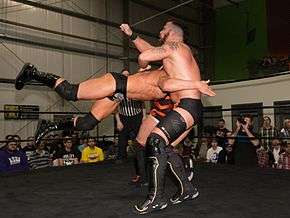
Also known as a shoulder block takedown, this is an attack where an attacking wrestler charges towards a standing opponent, brings his body parallel to the ground and drives his shoulder into the opponent's midsection, pulling on the opponent's legs, as in a double leg takedown, and forcing them back-first into the mat.
Striking spear
Also known as a high-impact spear, in this variation, the wrestler charges towards a standing opponent and drives his shoulder into the opponent's midsection, tackling the opponent and forcing them down into the mat back-first. In this maneuver, however, the wrestler does not pull on the opponent's legs, as in a double leg takedown, and relies on the momentum of the strike to force the opponent down. Professional wrestler Rhyno uses this variation as his finisher, calling it the Gore.
Turnbuckle thrust
This move is a shoulder block performed to an opponent who is set up on the turnbuckle. The opponent is often resting back first against the turnbuckles. The wrestler can run at the opponent, but normally the wrestler will place his/her shoulder against the opponent and swing their legs back and forth, driving their shoulder into the opponent’s chest, often repeatedly to then gain momentum.
Standing moonsault
A move in which a wrestler, who is standing next to an opponent lying on the ground, turns his back to the opponent and executes a standing backflip, landing on the opponent chest-first.
Standing shooting star press
This move sees the opponent lying on his back. The wrestler who's facing against either opponent's sides, jumps forward performing a backflip into the midair, and landing into the opponent's chest first in a press style.
Stink Face
This move sees a wrestler rubbing their buttocks in the face of an opponent lying in the corner of the ring,[9] done to humiliate the opponent. This move was popularized by Rikishi.
Uppercut
The uppercut is a punch used in boxing that usually aims at the opponent's chin. It is, along with the hook, one of the two main punches that count in the statistics as power punches. In boxing an uppercut only refers to a punch, while in wrestling other forms of uppercuts are used including an open-handed punch version (see throat thrust below).
European uppercut
This is a forearm uppercut in which a wrestler does a quick grapple then brings their arm up inside to hit the opponent under the chin.
Knee lift
This is an uppercut using the wrestler's knee in which a wrestler brings their knee up to hit the opponent under the chin.[1] This can either be performed in mid clinch or with the attacking wrestler charging at a kneeling or bent over opponent, lifting their knee upwards to strike underneath the jaw or the side of their head.[1]
Double knee lift
The wrestler forces the opponent’s head down, then quickly jumps, bending at the knees, and hits the opponent in the face or chest.[1]
Throat thrust
Also known as a throat strike, sword stab, or an open-hand uppercut, this attack is similar to a conventional uppercut, but the wrestler strikes at the opponent's throat with an open hand usually with their palm facing upwards and with all five fingers together.[1] This move can also be done with the opponent in a side headlock.[1]
Weapon shot
Many items are used as weapons in professional wrestling. Some of the more common weapons used include chairs, guitars, folding tables, title belts, "kendo sticks", and trash cans. While picking up the upper half of the ring steps for use as a weapon is illegal, slamming an opponent into the ring steps is not considered illegal, though it is frowned upon. However, these weapons are legal in hardcore matches.
Chair shot

A wrestler simply hits the opponent with a chair. In modern wrestling steel/metal folding chairs are used with the strike being performed with the flat face of the chair to slow the swing and distribute the impact, to prevent injury.
Chair thrust
This chair shot variation sees the wrestler placing the top of a folded chair under the opponent's chin or by the Adam's Apple, and then while holding the chair with one hand and the back of the opponent's head with another, the wrestler hits the mat with the legs of the folded chair while still placed under the opponent's chin and simultaneously forcing the opponent's head down, thus highly damaging that part of the opponent. The move can be alternatively called a guillotine shot.
Guitar shot
Simply involves breaking a guitar over an opponent's head. Also known as the El Kabong, a reference to Quick Draw McGraw who would say this phrase prior to hitting someone with a guitar.
Con-chair-to
This particular attack was popularized by Edge and Christian and involved two wrestlers sandwiching an opponent's head between two chairs with a simultaneous chair shot from both sides.[10] The "One Man Con-chair-to" involves a wrestler placing their opponent so that they are horizontal with their head resting on a chair, then hitting their head from above with a second chair, squashing the head of the opponent between both.
Transition moves
Some moves are meant neither to pin an opponent, nor weaken them or force them to submit, but are intended to set up the opponent for another attack.
Discus
This is a move in which a wrestler will spin in place before hitting an attack, like the discus clothesline, discus punch, or the discus forearm. The move is usually used instead of charging towards an opponent to build up momentum for an attack, or using the discus spin to evade other attacks.
Handspring
The wrestler runs towards the ropes and performs a handstand right next to them, using his momentum to throw his legs against the ropes, using the spring to throw himself backwards back onto his feet, and using the momentum still to leap backwards, usually to deliver an attack. A back elbow strike variation is the most common. Another common variation of the handspring transition sees the attacking wrestler Irish-whip their opponent onto a turnbuckle from an adjacent corner. Once the opponent crashes with their back onto the turnbuckle, the wrestler immediately performs a handspring combo towards the opponent across the ring. The acrobatic combination usually consists of a cartwheel followed by one or two back-tucks leaving the wrestler's back facing the opponent. When the wrestler is in close range of the opponent, they are free to use the momentum of the handspring combination to leap backwards and strike with either a back-elbow, a back-thump, a dropkick or any other convenient attack.
Pendulum
This is a move in which a wrestler performs a tilting sequence, similar to that of an actual pendulum, in between the ring ropes (usually near a ringpost) in order to gain momentum to perform an attack or a counterattack.
Rolling Thunder
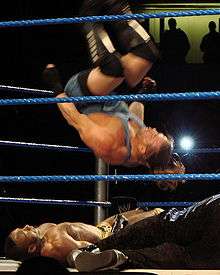
A rolling thunder refers to the action of a forward roll towards an opponent using the complete rotation to spring up onto their feet and into the air and perform an attack. The most popular version of this ends it with a jumping somersault senton.
Illegal attacks
Illegal attacks are mainly used by villains and are theoretically an offense punishable by disqualification, though typically done when the referee is disabled or otherwise distracted. The most well-known illegal moves are ones that attack the groin of a male wrestler.
Asian mist
Asian mist refers to the illegal maneuver of spitting a colored liquid into the face of an opponent in professional wrestling. After doing so, the opponent will (in storyline) be blinded and experience intense stinging in the eyes. Asian mist can come in almost any color, but the most common one used is green.[11] On rare occasion, a wrestler will use a flammable substance (e.g. alcohol).[12][13]
- Green Mist – The most common mist, which obscures the opponent's vision.
- Red Mist – This mist is purported to burn rather than blind.
- Black Mist – An even more powerful mist which is purported to severely blind an opponent for a prolonged period of time.
- Blue Mist – This mist is used to send an opponent to sleep.
- Yellow Mist – This mist is purported to paralyze the opponent.
Biting
The wrestler seizes a body part of the opponent and bites down with their teeth. Biting is often used when a wrestler is "trapped", either in a corner of the ring or in a submission hold, as a desperation move.
Eye poke
Also called a thumb to the eye. When a wrestler pokes his thumb or finger(s) into an opponent's eye(s). This is an illegal attack mainly used by heel superstars to gain an upper hand on their opponent.
Eye rake
This is when a wrestler moves his hand down past an opponent's eye(s), making it appear that the wrestler has dragged his/her fingers across the opponent's eye(s), to cause pain and visual problems.[1] This is an illegal attack mainly used by heel superstars to gain an upper-hand on their opponent.
Fireball
The wrestler (using a concealed lighter) lights a piece of quick-burning paper (flash paper) and throws it at the opponent's face, giving the impression of a supernatural ball of fire emerging from their hand.
Hangman
Seen when a wrestler who is on the opposite side of the ring ropes from an opponent (on the 'apron') grabs him by the head and drops down, forcing the opponent's throat across the ropes. This is an illegal attack because of its use of the rope. A common variation sees the wrestler perform a catapult to the opponent while the opponent is lying down in between the bottom and second ropes.
Reverse hangman
Similar to the normal hangman, which sees the wrestler standing outside the ring or on the apron, grabs the back of the opponent's head or neck (who is lying against the set of ropes, facing to the inside of the ring) into the ropes. The move can be alternatively called a "reverse" hotshot.
Hair pull
As the name implies, this move sees one wrestler take advantage of another's long hair by pulling it. In modern mainstream wrestling, it is more commonly used by female wrestlers. Similarly to a submission hold in the ropes, or a choke, the wrestler is given a five count to stop, before being disqualified.
Low blow
A direct shot to the groin of an opponent;[1] otherwise known as a groin attack. It is an offense punishable by disqualification. This illegal attack is mainly used by heel superstars or valets to gain the upper hand on their male opponents. Although kicking an opponent in the groin is the most obvious method, the most popular version sees an attacking wrestler drop to their knees and raise their arm up between the opponent's legs, striking the groin with the inside of their elbow-joint. Often wrestlers will perform the strike while the referee is in some way distracted in what is known as a "cheap shot". In lucha libre, this is referred to as a "fault" or "foul".[14]
Testicular claw
A version of a clawhold in which a wrestler will grab hold of an opponent by the testicles and squeeze. This is an illegal attack mainly used by wrestlers to gain the upper hand on their opponents and is an offense punishable by disqualification. Another version rarely used in woman's wrestling is called the Vaginal Claw.
See also
- Professional wrestling holds
- Professional wrestling throws
- Professional wrestling aerial techniques
- Professional wrestling double-team maneuvers
Notes
- 1 2 3 4 5 6 7 8 9 10 11 12 13 14 15 16 17 18 19 20 21 22 23 24 25 26 27 28 29 30 31 32 33 34 35 36 37 38 39 40 41 42 43 44 45 46 "Professional Wrestling Moves: Part 1". Death Valley Driver.com. Archived from the original on 2013-05-06. Retrieved 2007-11-29.
- ↑ Sarah Preston (March 2008). "The Dirty Dozen: WWE Diva Maria". Playboy.com. Retrieved 2008-03-19.
- ↑ Laurer, Joanie (2001). If They Only Knew. ReaganBooks. p. 96. ISBN 0-06-109895-7.
- 1 2 Foley, Mick. Have A Nice Day: A Tale of Blood and Sweatsocks (p.189)
- 1 2 Foley, Mick. Have A Nice Day: A Tale of Blood and Sweatsocks (p.4)
- ↑ UFC Rules
- ↑ "The 50 coolest maneuvers of all time - #14 Shawn Michaels' Sweet Chin Music". WWE. Archived from the original on 1 February 2015. Retrieved 1 February 2015.
- ↑ "What a manoeuvre! 15 moves that really exist". WWE. 2012-11-30. Retrieved 2014-03-13.
- ↑ "Sexiest Women List 2007: #43: Torrie Wilson". FHM Online. Retrieved 2007-11-08.
- ↑ Copeland, Adam (2004). Adam Copeland on Edge. WWE Books. p. 158.
We [Edge and Christian] became known as "the chairmen of the WWE" with our illegal finishing move, the Conchairto. Essentially a chair sandwich around our opponents' heads.
- ↑ "the 50 coolest maneuvers of all time". WWE. 2014-02-21. Retrieved 2014-03-13.
- ↑ The Great Muta Returns and is Double Crossed! (July 24, 2014)
- ↑ James Storm and the Great Sanada vs. Austin Aries and Tajiri (with James Storm's Beer Mist, Sept 10, 2014)
- ↑ "Learn about lucha libre". Roma Pro Wrestling. Retrieved 12 July 2015.
References
- Mick Foley (2000). Have A Nice Day: A Tale of Blood and Sweatsocks. HarperCollins. p. 511. ISBN 0-06-103101-1.
- LeBelle, Gene. Gene Lebell's Grappling World: The Encyclopedia of Finishing Holds. Sports Publishing LLC, 2005. ISBN 0-9676543-1-9.
- McAvennie, Michael (2006). WWE: Signature Moves. ISBN 1-4165-3280-3.
- Harley Race, Ricky Steamboat, Les Thatcher, and Alex Marvez. The Professional Wrestlers' Workout & Instructional Guide.
- Adam Copeland (2004). Adam Copeland on Edge. Pocket Books. ISBN 0-7434-8347-2.
External links
| Wikimedia Commons has media related to Professional wrestling attacks. |
| ||||||||||||||||||||||